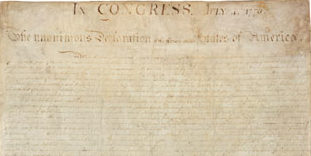
Interpreting a Foundational Document.
The Declaration of Independence was written by Thomas Jefferson and four other statesmen at the Continental Congress and signed on July 4, 1776. Drawing from enlightened philosophers on government, the document explained how recent abuses by the too powerful English crown violated individual rights, justified the colonists’ separation from the mother country, and defined the newly independent states’ relationship.
When in the Course of human events, it becomes necessary for one people to dissolve the political bands which have connected them with another . . . they should declare the causes which impel them to the separation. We hold these truths to be self-evident, that all men are created equal, that they are endowed by their Creator with certain unalienable Rights, that among these are Life, Liberty and the pursuit of Happiness.–That to secure these rights, Governments are instituted among Men, deriving their just powers from the consent of the governed, –That whenever any Form of Government becomes destructive of these ends, it is the Right of the People to alter or to abolish it . . . The history of the present King of Great Britain is a history of repeated injuries and usurpations . . . He has refused his Assent to Laws, the most wholesome and necessary for the public good . . . He has called together legislative bodies at places unusual, uncomfortable, and distant . . . He has dissolved Representative Houses repeatedly, for opposing with manly firmness his invasions on the rights of the people . . . He has plundered our seas, ravaged our Coasts, burnt our towns, and destroyed the lives of our people . . . That these United Colonies are, and of Right ought to be Free and Independent States . . . And for the support of this Declaration, with a firm reliance on the protection of divine Providence, we mutually pledge to each other our Lives, our Fortunes and our sacred Honor.Declaration of Independence, U.S. Archives
Analyze and Interpret:
1. Describe the author’s perspective, claims, and reasoning.
2. What political principles, institutions, or processes likely resulted from this issuance of this document?